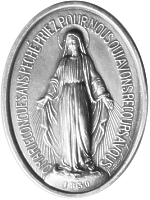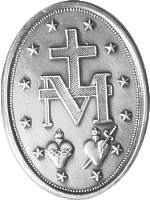|
On
the night of 18 July, 1830, a "child" awakened Sr. Catherine Labouré
(seen above) in her Daughters of Charity convent at 140 Rue du
Bac, Paris, telling her to go to the convent's chapel where Mary
awaited her. There Mary told her:
God wishes to charge you with a mission. You will be
contradicted, but do not fear; you will have the grace. Tell your
spiritual director all that passes within you. Times are evil in France
and in the world. Come to the foot of the altar. Graces will be shed on
all, great and little, especially upon those who seek them. Another
community of sisters will join the Rue du Bac community. The community
will become large; you will have the protection of God and Saint
Vincent; I will always have my eyes upon you.
Later
that year, on 27 November, Catherine saw another vision of Mary.
She describes her like this:
Her height was medium and her countenance, indescribably
beautiful. She was dressed in a robe the color of the dawn,
high-necked, with plain sleeves. Her head was covered with a white
veil, which floated over Her shoulders down to her feet. Her feet
rested upon a globe, or rather one half of a globe, for that was all
that could be seen. Her hands which were on a level with her waist,
held in an easy manner another globe, a figure of the world. Her eyes
were raised to Heaven, and her countenance beamed with light as She
offered the globe to Our Lord.
Mary
told her that the globe represented the whole world, especially
France, a country whose faithful had recently suffered horrible
persecutions in the Revolution's Terrors and was still going through
"Enlightenment" perfidy.
The vision changed to Mary, still standing on a globe, rays of light
streaming from her fingers, enframed in an oval frame inscribed with
the words, "O Mary, conceived without sin, pray for us who have
recourse to thee." The whole vision "turned" showing the back of the
oval inscribed with the letter "M" entwined with a Cross, and the
hearts of Jesus and Mary, the former surrounded with thorns, the latter
pierced with a sword. 12 stars circled this oval frame, symbolizing the
12 Tribes of Israel and the 12 Apostles, and showing Mary as the Mother
of Israel, per the Apocalypse (ch. 12). Mary told her to strike a medal
in this form, and that all who wore it after having it blessed would
receive graces.
 
Sr. Catherine's spiritual director told Catherine's story to the Bishop
of Paris, who not only allowed the medal to be struck, but received
some of them himself. One of these he had with him when
ministering to Napoleon's dying, heretical chaplain. The dying man had
obstinately refused to reconcile with the Church, but as the Bishop was
leaving after trying one last time to get him to see the error of his
ways, the man suddenly broke down and repented. The Bishop attributed
this to the Virgin's intercessions through the medal.
Another miraculous conversion involved that of a wealthy Jewish
banker-lawyer named Alphonse Ratisbonne. He was actually dared to wear
one of the medals and to pray the Memorare.
This he did, and as he visited a church to arrange a funeral for a
friend, he had a vision of Our Lady as she appears on the Medal. He
instantly converted, and became a priest.
The Medal of the Immaculate Conception, now known as the Miraculous
Medal, has become one of the most commonly worn sacramentals in the
Roman Church.
St. Catherine Labouré's body remains incorrupt
to this day and can be seen at her convent at Rue du Bac.
Read also about devotion to the Immaculate Heart.
Notes
St. Maximillian Kolbe (+ 1941) adopted the miraculous medal as
the badge of the "Pious Union of the Militia of the Immaculate
Conception" in 1917, which he founded in Rome while still a young
religious of the Conventual Friars Minor.
Another story about the Miraculous Medal that you should be aware of is
that of Alphonse Ratisbonne. Ratisbonne was a Jewish man from
Strasbourg, an atheist described by the Catholic Encyclopedia as "a
radical infidel, a scoffer at religion." In spite of that, he wore the
Miraculous Medal at the insistence of a friend, an act which paid off:
when visiting the Church of S. Andrea delle Fratte in Rome, he had a
vision of Our Lady as she appears on that medal. He immediately
converted, added "Marie" to his name to become "Marie-Alphonse
Ratisbonne," and then was ordained. He went on to found the Sisterhood
of Our Lady of Sion, with whom he worked in Jerusalem for the
conversion of Jews and Muslims until his death in 1884. You can find
the pdf of a book recounting his conversion story in this site's Catholic
Library.
|
|

